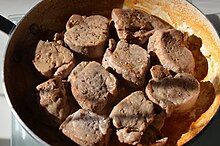| This article needs additional citations for verification. Please help improve this article by adding citations to reliable sources. Unsourced material may be challenged and removed. Find sources: "Filet mignon" – news · newspapers · books · scholar · JSTOR (May 2009) (Learn how and when to remove this message) |
 Diagram of where filet mignon is butchered from Diagram of where filet mignon is butchered from | |
| Type | Tenderloin |
|---|---|


Filet mignon (/ˌfiːleɪ ˈmiːnjɒ̃/; French: [filɛ miɲɔ̃]; lit. 'delicate, fine, or cute fillet') is a cut of meat taken from the smaller end of the tenderloin, or psoas major of a cow. In French, it mostly refers to cuts of pork tenderloin.
The tenderloin runs along both sides of the spine, and is usually butchered as two long snake-shaped cuts of meat. The tenderloin is sometimes sold whole. Filet mignon is usually presented as a round cut taken from the thinner end of a piece of tenderloin. It is often the most tender and lean cut. Filet mignon often has a milder flavour than other cuts of meat and as such is often garnished with a sauce or wrapped with bacon.
Due to the small amount of filet mignon able to be butchered from each animal, it is generally considered one of the most expensive cuts of beef.
Usage
Europe

In France, the term filet mignon refers to pork. The cut of beef referred to as filet mignon in the United States has various names across the rest of Europe; e.g., filet de bœuf in French and filet pur in Belgium, fillet steak in the UK, Filetsteak in German, solomillo in Spanish (filet in Catalan), lombo in Portuguese, filee steik in Estonian, and filetbiff in Norwegian.
In the UK, pork fillet or pork medallion is the term used to describe a similar cut from a pig.
North America
Filet mignon refers to cuts from a beef tenderloin in North America. Elsewhere, this cut of beef is called:
- Filet de bœuf (French)
- Fillet steak (English: UK, Ireland, South Africa)
- Eye fillet (English: Australia, New Zealand).
In the U.S., both the central and large end of the tenderloin are often sold as filet mignon in supermarkets and restaurants. The French terms for these cuts are tournedos (the smaller central portion), châteaubriand (the larger central portion), and biftek (cut from the large end known as the tête de filet (lit. 'head of filet') in French).
Porterhouse steaks and T-bone steaks are large cuts that include the filet. The small medallion on one side of the bone is the filet, and the long strip of meat on the other side of the bone is the strip steak.
See also
References
- "filet mignon". Oxford Dictionaries. Oxford University Press. Archived from the original on August 2, 2013. Retrieved 2015-11-13.
- Hamlyn (2009). Larousse Gastronomique. UK: Hamlyn. p. 989. ISBN 978-0600620426.
- Jacobson, Derek (2018-01-02). "What Are the Most Expensive Steak Cuts?". Steak University. Retrieved 2022-11-03.
- Beck et al, pp. 306–307
Sources
- Beck, Simone; Louisette Bertholle; Julia Child (2012) . Mastering the Art of French Cooking, Volume One. London: Particular. ISBN 978-0-241-95339-6.
| Cuts of beef | ||
|---|---|---|
| Upper |   | |
| Lower | ||